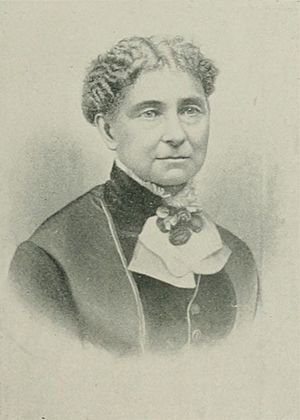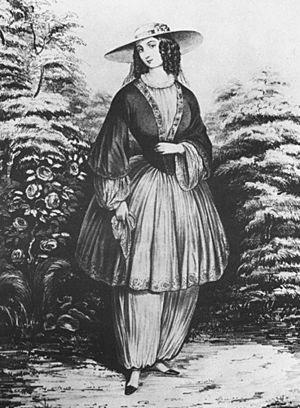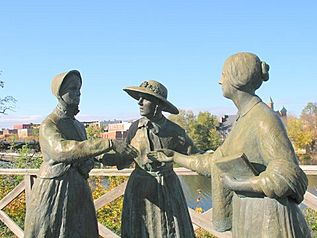Amelia Bloomer facts for kids
Quick facts for kids
Amelia Bloomer
|
|
|---|---|
 |
|
| Born |
Amelia Jenks
May 27, 1818 Homer, New York, United States
|
| Died | December 30, 1894 (aged 76) Council Bluffs, Iowa, United States
|
| Monuments | Amelia Bloomer House |
| Nationality | American |
| Occupation | Women's rights and temperance advocate |
| Known for | Publicizing the idea of women wearing pants which came to be known as "Bloomers" |
|
Notable work
|
owner/editor of The Lily |
| Spouse(s) | Dexter Bloomer (m. 1840) |
Amelia Jenks Bloomer (born May 27, 1818 – died December 30, 1894) was an American newspaper editor. She also worked for women's rights and the temperance movement. Even though she didn't invent the clothing style called bloomers, her name became famous because she strongly supported them. With her newspaper, The Lily, she was the first woman to own, run, and edit a newspaper just for women.
Contents
Amelia Bloomer's Early Life
Amelia Jenks was born in 1818 in Homer, New York. Her parents were Ananias and Lucy Jenks. She was one of the youngest in a big family with at least six siblings. Her family did not have much money. Amelia only went to school for a few years in her local town.
Amelia Bloomer's Career Beginnings
When she was 17, Amelia worked as a school teacher for a short time. Then she moved to Waterloo to live with her sister, Elvira. A year later, she moved to Seneca Falls. There, she worked as a governess for the three youngest children of the Oren Chamberlain family.
On April 15, 1840, Amelia married Dexter Bloomer. She was 22 years old. Dexter was a law student who encouraged her to write for his newspaper. It was called the Seneca Falls County Courier. Dexter supported Amelia's work for social change.
Amelia and her family lived in Cortland County, New York, for some years. In 1852, they moved to Iowa.
Amelia Bloomer's Social Activism
In 1848, Amelia Bloomer went to the Seneca Falls Convention. This was the first meeting about women's rights. She did not sign the Declaration of Sentiments there. This was because of her strong beliefs with the Episcopal Church. However, this meeting inspired her to start her own newspaper.
Starting The Lily Newspaper
The next year, Amelia began editing The Lily. This was the first newspaper made by and for women. It was published every two weeks from 1849 to 1853. The newspaper started as a journal for the temperance movement. But it soon included many different topics. These ranged from recipes to moral stories. This happened especially when suffragists like Elizabeth Cady Stanton and Susan B. Anthony became involved.
Amelia believed that writing was the best way for women to work for change. This was because women speakers were often seen as improper. The Lily was first meant for members of the Seneca Falls Ladies Temperance Society. This group formed in 1848. Eventually, the newspaper had over 4,000 readers.
The newspaper faced some problems early on. The Temperance Society's interest faded. But Amelia felt it was important to keep publishing. So, she took full charge of editing and publishing the paper. At first, the newspaper's title page said "Published by a committee of ladies." After 1850, only Amelia Bloomer's name was on the masthead. This newspaper became a model for later publications focused on women's suffrage.
Amelia Bloomer shared her experience as the first woman to own and edit a newspaper for women:
It was a needed instrument to spread abroad the truth of a new gospel to woman, and I could not withhold my hand to stay the work I had begun. I saw not the end from the beginning and dreamed where to my propositions to society would lead me.
Promoting Dress Reform for Women
In her newspaper, Amelia Bloomer supported a change in women's clothing. She wanted clothes that were less restrictive for daily activities. She wrote:
The costume of women should be suited to her wants and necessities. It should conduce at once to her health, comfort, and usefulness; and, while it should not fail also to conduce to her personal adornment, it should make that end of secondary importance.
In 1851, a temperance activist named Elizabeth Smith Miller started wearing a new outfit. It had loose trousers gathered at the ankles. These were like pants worn by women in the Middle East. She wore them with a short dress or skirt and a vest. Miller showed her new clothes to her cousin, Elizabeth Cady Stanton. Stanton thought the outfit was smart and looked good, so she started wearing it too.
Stanton visited Amelia Bloomer while wearing this outfit. Amelia liked it and began to wear it herself. She also promoted it strongly in her magazine. News articles about this new clothing trend appeared in The New York Tribune. More women started wearing the fashion. It was quickly named The Bloomer Costume or "Bloomers".
However, the bloomers were often made fun of in newspapers. Women who wore them also faced teasing on the street. Amelia Bloomer herself stopped wearing the fashion in 1859. She said that a new invention, the crinoline, was enough of a reform. So, she could go back to wearing traditional dresses.
Later Activism and Legacy
Also in 1851, Amelia Bloomer introduced two important suffragettes to each other: Elizabeth Cady Stanton and Susan B. Anthony.
In 1854, Amelia and her husband moved to Council Bluffs, Iowa. Amelia sold The Lily newspaper to Mary Birdsall in Richmond, Indiana. Birdsall and Dr. Mary F. Thomas continued to publish the paper until at least 1859.
Amelia Bloomer remained a pioneer for women's voting rights and a writer throughout her life. She wrote for many different publications. While she might not be as famous as some other feminists, she made many important contributions to the women's movement. This was especially true for dress reform. Amelia also led campaigns for women's voting rights in Nebraska and Iowa. She was president of the Iowa Woman Suffrage Association from 1871 to 1873.
Death and Burial
Amelia Bloomer died in 1894. She was 76 years old. She is buried in Fairview Cemetery in Council Bluffs, Iowa.
Commemorations and Honors
Amelia Bloomer is honored in the calendar of saints of the Episcopal Church on July 20. She is remembered along with Elizabeth Cady Stanton, Sojourner Truth, and Harriet Ross Tubman. In 1975, she was added to the Iowa Women's Hall of Fame.
In 1980, her home in Seneca Falls, New York, known as the Amelia Bloomer House, was listed on the National Register of Historic Places. In 1995, she was inducted into the National Women's Hall of Fame.
In 1999, a sculpture by Ted Aub was revealed. It celebrates the meeting on May 12, 1851, when Amelia Bloomer introduced Susan B. Anthony to Elizabeth Cady Stanton. This sculpture is called "When Anthony Met Stanton." It shows the three women as life-size bronze statues. It is located overlooking Van Cleef Lake in Seneca Falls, New York, where the introduction happened.
From 2002 to 2020, the American Library Association created an annual Amelia Bloomer List. This list featured recently published books with important feminist themes for young readers. However, in 2020, the list's name was changed to Rise: A Feminist Book Project for Ages 0–18. This change was made because Amelia Bloomer did not speak out against the Fugitive Slave Law of 1850. The committee wanted the list to better reflect diversity and inclusion.
See also
 In Spanish: Amelia Bloomer para niños
In Spanish: Amelia Bloomer para niños




